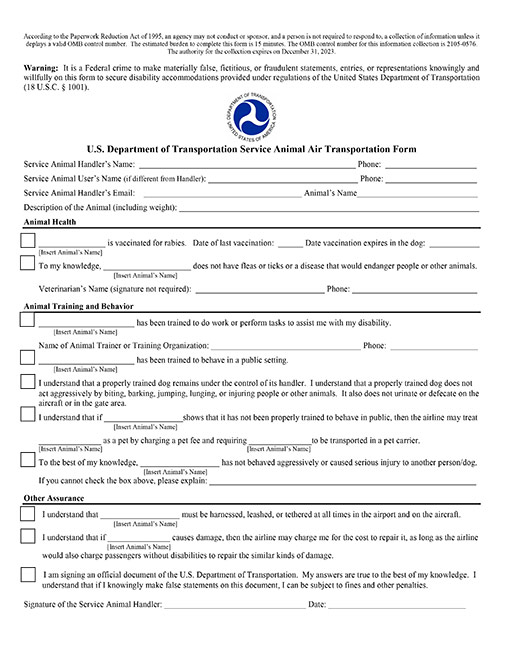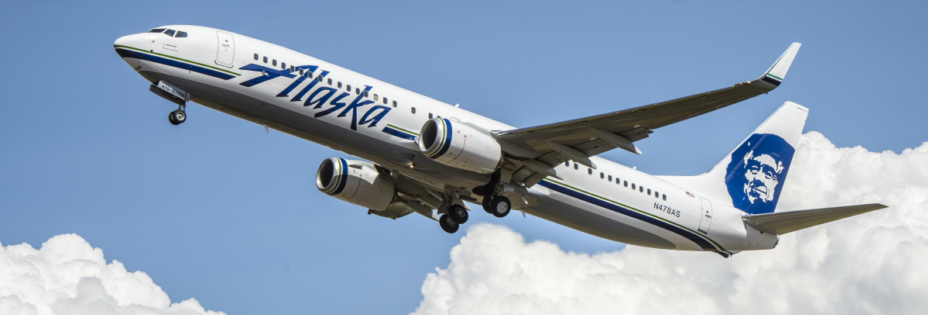This article was last updated on November 30, 2023, to reflect Alaska Airline’s latest process.
If Alaska is your airline of choice and you’re planning to fly with an emotional support animal (ESA) or service dog, this guide is for you.
You may have heard there were some major changes to the Department of Transportation’s regulations for assistance animals. As a result, U.S. airlines, including Alaska Airlines, no longer accept emotional support animals.
If you own an ESA, your alternatives are to fly with them as a regular pet or, if needed due to the owner’s disability, to train them to become a psychiatric service dog (PSD). If your ESA doesn’t qualify as a PSD, small pets can board the cabin on Alaska Airlines as long as they fit into a pet carrier. For pets, a fee is assessed on each leg of the flight.
If you own a service dog or are in the process of training one, read on to find out what Alaska Airlines requires for your service dog to board the cabin.
All airlines still accept Psychiatric Service Dogs on all flights.
If you are interested in a Psychiatric Service Dog Letter, we are happy to connect you with a licensed healthcare provider so they may assist you.
How to Fly with a Service Dog on Alaska Airlines
Traveling with a service dog on Alaska Airlines is a 2-step process that must be completed at least 48 hours before your departure. Alaska recommends starting the process at least 5 days prior to departure if possible.
These are the two steps to travel with a service dog on Alaska Airlines:
Step 1:
First, you will need to complete a DOT Service Animal Air Transportation Form online to receive an SAFP Service Animal ID. Alaska works with a company called Open Doors Organization to accept the form.
To request a SAFP Service Animal ID, you’ll need to have the following information available to complete the form:
- Veterinarian’s name and contact number
- Rabies vaccination date and expiration
- Trainer’s name/organization and contact number (this will be you if you self-trained your dog)
Once approved, your Service Animal ID is valid through the expiration date of your dog’s rabies vaccine. You don’t have to complete this step again until it’s time to update your dog’s vaccination record.
Step 2:
Once you have an SAFP Service Animal ID and have booked a flight on Alaska Airlines, you can request travel with your service animal
This step must be completed each time you make a reservation on Alaska Airlines. Once approved, you will receive a 6-letter confirmation code.
You will be required to complete this DOT Form. Not sure how to complete the DOT Form? You can find instructions here.
While at the airport and on the plane, Alaska Airlines team members can ask two questions under federal law to verify your service dog:
- Is the service dog required because of a disability?
- What task or job has the dog been trained to perform?
A disability for purposes of the DOT’s rules includes physical disabilities as well as mental and emotional health conditions and learning disorders that substantially limit a major life activity.
Rules that Apply to Service Dogs during Flights on Alaska Airlines
There are some ground rules to flying with a service dog on Alaska Airlines you should be familiar with before boarding your flight:
- Your service dog cannot exceed the footprint or personal space of your seat or foot area during the flight.
- Your service dog must be harnessed, leashed, or tethered and under your control at all times.
- Your service dog must be seated on the floor space below the seat. Your service dog can sit in your lap to help with your condition if it is no larger than an infant.
- Service dogs cannot sit in seats or on tray tables, and they also cannot occupy the aisles or emergency rows.
You should also be confident that your service dog can handle the hustle and bustle of a busy airport and crowded plane. Service dogs can be banned from a flight if they are disruptive or cause a safety or health hazard for other passengers. Examples of unacceptable behaviors include:
- Excessive barking
- Not responding to the handler’s needs or commands
- Freely wandering or running around
- Relieving themselves in appropriate areas
- Jumping on other people
- Eating off tray tables
Travel to Hawaii
Hawaii’s Department of Agriculture requires health documentation for service dogs to maintain its rabies-free status. Service dogs arriving without proper documentation may be quarantined for up to 120 days at the owner’s expense.
Note that service dogs are not allowed on flights arriving in Honolulu after 10:00 pm. A valid Neighbor Island Inspection Permit is required for flights to Kona, Lihue, or Kahului.
Upon arrival in Honolulu, Kona, Lihue, or Kahului, a gate agent will escort you and your service dog to the inspection station.
International Travel
Alaska recommends contacting the consulate or embassy at least 4 weeks before departure to understand specific documentation requirements for the country you are flying to. Failure to provide necessary documents may result in quarantine at your expense.
Service Dogs in Training
Service dogs in training may be accepted at no charge at Alaska’s discretion, subject to availability and certain conditions, such as being transported by a trainer or traveling wholly within the U.S. Requests must be made 48 hours in advance by contacting Alaska’s reservations department.
Qualifying for a Psychiatric Service Dog
Psychiatric service dogs are used to treat many of the same conditions that emotional support animal owners suffer from. That has led many ESA owners to ask whether they would qualify for a psychiatric service dog.
While ESAs and PSDs are used for similar mental and emotional health issues, they are very different in terms of training requirements and usage. An ESA provides comfort just by being around its owner; no special training is needed. In comparison, PSDs are highly trained to assist their handlers and function in public settings around other people and animals. For a complete guide on psychiatric service dogs, click here.
If you’re wondering whether you might have a qualifying disability or you’re a current PSD owner who wants backup documentation, ESA Doctors can help. ESA Doctors can pair you with a healthcare professional licensed for your state to evaluate your mental and emotional health and provide a signed PSD letter if you qualify.
How to Get Your Psychiatric Service Dog Letter from ESA Doctors
Traveling with a Pet on Alaska Airlines
If your pet or emotional support animal does not qualify as a service dog, it may still be able to board the plane cabin as a regular pet if it meets certain requirements and you pay a fee. On Alaska Airlines, there are many restrictions for pets to be aware of before booking a flight. Alaska Airlines accepts household pets that are dogs, cats, rabbits, and birds. If you have a dog or cat, they must be at least 2 months old and be fully weaned.
Alaska Airlines charges a pet fee of $100. To travel with a pet, it must fit in a carrier that is a maximum of 17 inches x 11 inches x 7.5 inches for a hard case or 17 inches x 11 inches x 9.5 inches for a soft case. The carrier has to be leakproof and fully enclose your pet with adequate ventilation.
Alaska Airlines accepts a limited number of pets on each flight, so you should book your reservation as early as possible. Alaska Airlines will accept one pet carrier in First Class seating and five pet carriers in the main cabin on each flight.
Other rules to be aware of when traveling with Alaska:
- You are allowed to bring the pet carrier with a personal item or the pet carrier together with a standard-sized carry-on bag.
- You can have a maximum of two carriers in the main cabin only if you have also purchased the seat next to you.
- Pets are not allowed to occupy seats by themselves.
- You can have two pets of the same species and similar size in one pet carrier as long as no part of their body protrudes from the carrier and they are not in distress.
- Your pet must remain in the carrier with the doors and flaps secured at all times, including at the boarding area and during the flight. The pet carrier must be stowed under the seat during taxi, takeoff, and landing.
- Your pet cannot have any offensive odors or create any noise disturbances.
Final Thoughts
Whether you’re flying with a service dog or regular pet, letting Alaska Airlines know ahead of time, becoming familiar with their rules, and submitting any required documents before departure ensures a stress-free experience at the airport.
Airline rules for service dogs can change, so be sure to check Alaska’s website and talk with an agent if needed when booking your travel to have the most up-to-date information on their service dog policies.
The information on this page is for general informational purposes and should be confirmed directly with the airline. ESADoctors.com is not associated or affiliated with this airline or any of its subsidiaries.





